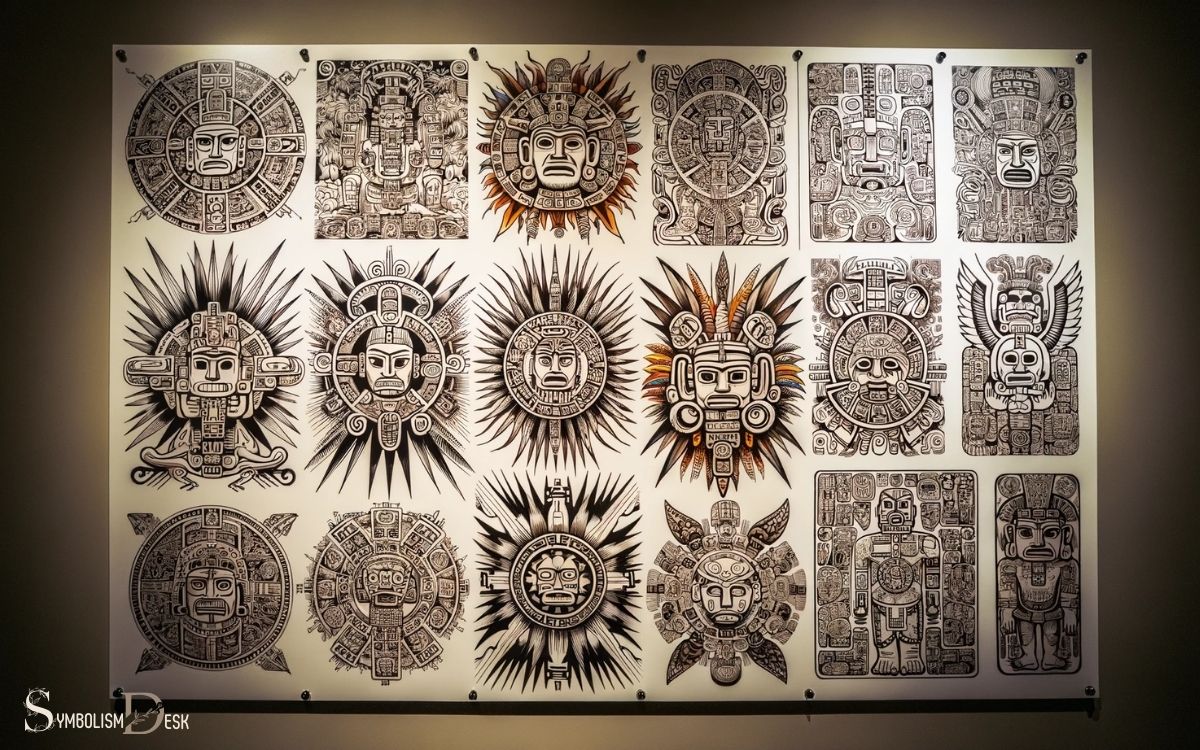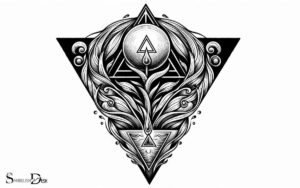Aztec Symbols and Meanings Tattoos: Explanations!
Aztec symbols and meanings in tattoos represent a profound connection to an ancient civilization’s mythology, deities, and cultural practices.
These tattoos often feature intricate designs such as the Aztec calendar, warrior symbols, and various gods, each holding specific significance and often chosen for their spiritual and historical resonance.
Aztec tattoos are deeply ingrained with the history and spirituality of the Aztec culture. The symbols used in these tattoos are not merely decorative but are loaded with specific meanings and stories from the Aztec tradition.
For example:
- The Aztec calendar, known as the ‘Sun Stone,’ signifies the Aztec understanding of time and the cosmos.
- Eagle designs symbolize strength, courage, and the warrior’s spirit.
- The feathered serpent god Quetzalcoatl is associated with wisdom, creation, and the priesthood.
Incorporating Aztec symbols into tattoos pays homage to a rich heritage and offers a timeless connection to the wisdom of an ancient world.

Key Takeaway
Brief History of Aztec Culture
The Aztec culture emerged in the 13th century and thrived in central Mexico until the Spanish conquest in the 16th century.
At its peak, the Aztec civilization was advanced and complex, with a rich tapestry of religious beliefs, artistic traditions, and a sophisticated social and political structure.
The Aztecs, also known as Mexica, founded their capital city of Tenochtitlan in 1325, which is now present-day Mexico City.
They were skilled in agriculture, architecture, and warfare, and their society was organized around city-states, each ruled by a supreme leader.
The Aztecs left a lasting legacy through their intricate calendar system, monumental temples, and vibrant art, including intricate symbols and designs that are still influential today.
Understanding the historical context of the Aztec culture is crucial for appreciating the significance of their symbols and meanings in modern times.
Significance of Aztec Symbols
Aztec symbols hold deep historical and cultural significance, representing the complex belief systems and traditions of the ancient civilization.
While these symbols have been adapted into modern tattoo designs, their meanings have evolved to accommodate personal interpretations and expressions of identity.
Understanding the historical context and cultural representations of these symbols can provide a richer appreciation for their enduring significance in contemporary society.
Historical Cultural Representation
Symbolic representations in Aztec culture often convey deep historical significance, reflecting the complex beliefs and values of the civilization. The Aztec symbols hold historical cultural representation that reflects their worldview and societal structures.
Here are some key aspects:
- Religious beliefs: Many symbols were associated with Aztec gods and goddesses, representing various aspects of their religious beliefs.
- Social hierarchy: The use of symbols was a way to denote social status, with different symbols representing different ranks within the society.
- Astronomical significance: Aztec symbols often had ties to celestial bodies and astronomical events, reflecting their advanced understanding of the cosmos.
- Warfare and conquest: Some symbols were used to represent military prowess and conquest, often depicting victorious battles and capturing the spirit of the warrior.
- Agricultural symbolism: Many symbols were linked to agriculture, reflecting the importance of farming and fertility in Aztec society.
These historical representations provide valuable insights into the rich cultural tapestry of the Aztec civilization. Understanding these symbols is crucial for comprehending the depth of Aztec culture and its lasting impact on the world.
Transitioning into the subsequent section about ‘modern tattoo interpretations’, these historical representations continue to influence contemporary art forms and personal expressions.
Modern Tattoo Interpretations
One popular modern interpretation of Aztec symbols in tattoos involves incorporating their deep historical meanings into contemporary body art.
Aztec symbols hold significant cultural and spiritual relevance, and many individuals choose to integrate these symbols into their tattoos as a way to connect with the rich heritage of the Aztec civilization.
For example, the Aztec eagle symbolizes power, strength, and bravery, making it a popular choice for individuals seeking to convey these qualities through their tattoos.
The snake, representing rebirth and renewal, is another meaningful symbol often incorporated into modern tattoo designs.
Personalized Symbolic Meanings
When considering personalized symbolic meanings in Aztec tattoos, individuals often find that the historical and cultural significance of these symbols allows for a deep connection to their own personal beliefs and values.
The personalized symbolic meanings of Aztec symbols hold significance for many individuals, as they can represent various aspects of their lives, including:
- Spirituality: Aztec symbols such as the sun, moon, and serpent hold deep spiritual meanings for many people.
- Strength and Courage: Symbols like the eagle and jaguar are often chosen to represent strength and courage.
- Connection to Ancestry: Some individuals choose symbols that connect them to their Aztec ancestry, symbolizing a link to their heritage.
- Protection: Symbols like the Aztec god Huitzilopochtli or the warrior represent protection and defense.
- Individual Journey: The use of personalized combinations of symbols to represent an individual’s unique life journey and experiences.
Common Aztec Symbols and Their Meanings
Many Aztec symbols hold significant meanings that are important to understand for those considering them for tattoos.
The Aztecs had a rich symbolic language, and some of the common symbols include the sun stone, which represents the Aztec calendar and the duality of life and death. The feathered serpent, Quetzalcoatl, symbolizes fertility and creativity.
The eagle, holding a serpent, represents the founding of Tenochtitlan, the Aztec capital. The skull, often depicted with crossbones, signifies the cycle of life and death.
These symbols are deeply rooted in Aztec cosmology and religious beliefs, reflecting their worldview and societal values.
Understanding the meanings behind these symbols is crucial for anyone interested in Aztec-inspired tattoos, as they carry profound cultural significance and historical context. These symbols often represent themes such as strength, resilience, and the interconnectedness between humanity and the divine. Beyond their aesthetic appeal, they serve as a way to honor and connect with the rich heritage of Aztec civilization. Similarly, exploring roman symbol tattoo meanings can offer a deeper appreciation for classical traditions and the timeless values they symbolize.
These symbols are just a few examples of the rich and diverse Aztec symbolism.
Transitioning to the subsequent section, it’s essential to explore the symbolism of Aztec gods and their significance.
Aztec Gods and Their Symbolism
Continuing from the previous subtopic, frequently Aztec gods were depicted with symbols that held deep cultural and religious significance. The Aztec gods and their symbolism were integral to the religious and cultural practices of the civilization.
Some of the key Aztec gods and their symbols include:
- Huitzilopochtli: The god of sun and war, often depicted with a hummingbird symbol.
- Quetzalcoatl: The feathered serpent god associated with learning and knowledge, represented by a feathered serpent.
- Tlaloc: The rain god, typically depicted with goggle eyes and fangs, symbolizing the power of nature.
- Xipe Totec: The god of agriculture and rebirth, recognized by his flayed skin and golden color.
- Coatlicue: The earth goddess, often portrayed with a skirt of serpents and a necklace of hearts and hands.
Incorporating Aztec Symbols Into Tattoos
When incorporating Aztec symbols into tattoos, it’s crucial to consider the symbolic placement on the body and the cultural significance behind the chosen symbols.
Authenticity is key, and individuals should carefully research the meanings and historical context of the Aztec symbols they wish to incorporate into their tattoos to ensure they’re accurately representing the rich cultural heritage of the Aztec civilization.
Symbolic Placement on Body
Where should Aztec symbols be placed on the body when incorporating them into tattoos?
The placement of Aztec symbols in tattoos is significant and can vary based on the individual’s preference and the meaning they wish to convey.
Here are five common symbolic placements on the body:
- Back: Symbolic of strength and protection, Aztec symbols on the back can represent the notion of carrying the weight of one’s history and culture.
- Forearm: Often used to display symbols of power and courage, the forearm placement signifies a visible declaration of one’s connection to Aztec heritage.
- Chest: A prominent placement symbolizing the importance of the symbol to the individual, often reflecting their inner strength and resilience.
- Shoulder: Signifies protection and guidance, as if the symbol is watching over and guiding the individual.
- Leg: Reflects a connection to the earth and the grounding principles of Aztec culture, often representing resilience and stability.
Choosing Authentic Aztec Symbols
Incorporating authentic Aztec symbols into tattoos involves researching and selecting culturally significant designs. It’s crucial to understand the historical and cultural context of each symbol to ensure respect and accuracy.
Aztec symbols hold deep meanings and are often associated with their gods, rituals, and beliefs. For instance, the ‘Ollin’ symbol represents movement and evolution, while the ‘Eagle’ symbolizes power and strength.
Before incorporating these symbols into a tattoo, individuals should delve into Aztec history to appreciate the significance fully. Consulting with experts or individuals from Aztec descent can provide valuable insights.
It’s essential to approach these symbols with reverence, understanding their original use and significance to the Aztec civilization.
By doing so, individuals can ensure that their tattoos not only look beautiful but also honor the rich heritage of the Aztec culture.
Modern Interpretations of Aztec Tattoos
Modern tattoo artists incorporate Aztec symbols and designs into their work to create contemporary interpretations of traditional Aztec tattoos.
These modern interpretations often blend ancient Aztec motifs with modern tattoo techniques and styles, resulting in unique and visually striking designs.
Some common modern interpretations of Aztec tattoos include:
- Geometric patterns: Artists use traditional Aztec geometric designs as a base, incorporating modern geometric tattoo styles to create intricate and visually captivating patterns.
- Fusion with other cultural elements: Aztec symbols are combined with symbols from other cultures to create a fusion of meanings and aesthetics.
- Realism and surrealism: Some artists create realistic or surrealistic interpretations of Aztec deities and symbols, adding depth and dimension to the traditional designs.
- Minimalist approach: Simplified and minimalist versions of Aztec symbols are popular, often focusing on the essence of the symbol rather than intricate details.
- Watercolor techniques: Aztec designs are sometimes rendered using watercolor tattoo techniques, adding a vibrant and contemporary twist to the traditional symbols.
Cultural Appropriation and Aztec Symbol Tattoos
A significant number of individuals have raised concerns about the cultural appropriation of Aztec symbols in the context of tattoo art.
The use of Aztec symbols in tattoos by individuals outside of the Aztec culture has sparked debates about respect for indigenous cultures and their significance.
It’s crucial to understand the historical and cultural context of these symbols before using them in tattoos. The Aztec civilization had deep spiritual and religious beliefs associated with their symbols, and they often held specific meanings and significance within their society.
Therefore, it’s important to approach the use of Aztec symbols in tattoos with respect and understanding of their cultural and historical significance.
Engaging in open and respectful conversations with members of the Aztec community can provide valuable insights and help in avoiding cultural appropriation.
Conclusion
Aztec symbols hold deep cultural and historical significance, making them popular choices for tattoos. However, it’s important for individuals to understand the meaning behind these symbols and to respect the cultural context from which they originate.
For example, a person getting an Aztec symbol tattoo should take the time to learn about its meaning and significance in Aztec culture, rather than simply using it for aesthetic purposes. Understanding and honoring the cultural heritage behind these symbols is crucial.






